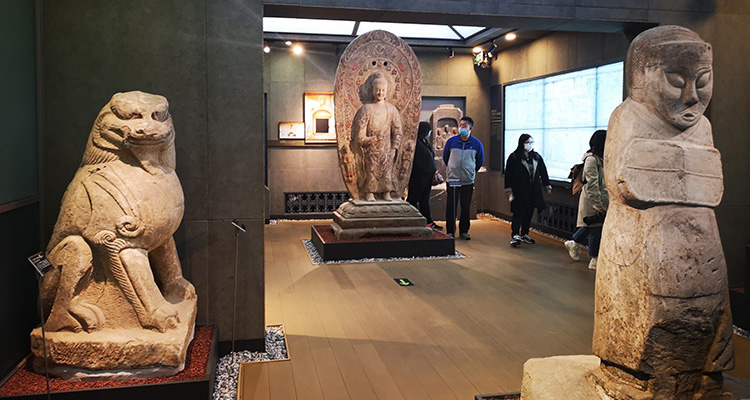Beijing Stone Carving Art Museum: The Stone Whisperer Beneath the Ancient Pagoda
Hidden in Beijing’s bustling Haidian District lies a serene pocket of time—Beijing Stone Carving Art Museum. Here, there’s no noisy crowd, only ancient stone carvings softly telling stories that span a millennium. Situated on the grounds of the Ming and Qing dynasty royal temple Zhenjue Temple, famous for its unique Diamond Throne Pagoda (topped with five smaller pagodas), locals affectionately call it the “Five-Pagoda Temple.” Stepping into this 20,000-square-meter site is like opening a three-dimensional history book, where each stone carving connects Beijing’s past and present.

1. Why You Should Make a Special Visit
A 600-Year Encounter:
Zhenjue Temple was built during the Yongle era of the Ming Dynasty (1403–1424) with a story that spans borders: an Indian monk presented Emperor Yongle with five golden Buddha statues and architectural plans for the Diamond Throne Pagoda, prompting the emperor to commission the temple. The Diamond Throne Pagoda is the oldest and most uniquely structured surviving tower of its kind in China—a true treasure of ancient stone carving. Its design blends the Indian Bodh Gaya style with traditional Chinese architectural carving, a successful example of cross-cultural exchange.
Beijing’s “Little Angkor”:
Although most of the temple was destroyed by fire in the late Qing Dynasty, leaving only the Diamond Throne, standing before the giant tower adorned with 1,561 Buddha carvings still delivers a strong visual impact. Many call it “Beijing’s Little Angkor” because its unique shape and detailed stonework allow visitors to escape urban noise and immerse themselves in an ancient, sacred atmosphere.
Tranquil Courtyards All Year Round:
The museum is a haven not only for history lovers but also for those seeking quiet moments. Two over 600-year-old ginkgo trees drape golden leaves in autumn, complementing the ancient pagoda—a stunning seasonal view. Compared to other busy attractions, visitors are few, allowing leisurely appreciation of each exhibit and the gentle flow of time.

2. What You’ll See
Signature Treasures and Core Exhibits:
- Diamond Throne Pagoda: The museum’s centerpiece. Covered in intricate carvings—Buddhas, Bodhisattvas, heavenly kings, arhats, lions, peacocks, golden-winged birds—its interior features a 44-step spiral staircase offering panoramic views of the courtyard.
- Beijing’s Earliest Stone Carving: The “Han Gu Youzhou Shuzuo Qin Jun zhi Shendao” pillar and stone gate components are the oldest dated inscriptions in Beijing, a stone chronicle of history.
- Calligraphy Masterpieces: Don’t miss engraved Ming and Qing calligraphy, such as “Yijin Zhai Tie” and “Jinghe Tang Tie”, invaluable for studying Chinese calligraphy.
Diverse Exhibit Layout:
The museum uses a “All Stars Worship the Moon” layout, centering on the Diamond Throne Pagoda with eight outdoor stone carving areas to its east, north, and west:
- Religious Stone Carvings: Including Northern Dynasties Buddhist sculptures.
- Tombstone Exhibits: From Tang to Qing, offering insight into ancient social life.
- Calligraphy Steles: Engravings from famous historical calligraphers.
- Stone Sculpture Art: Includes exquisite Yuan and Qing dynasty carvings.
Cultural and Educational Opportunities:
The indoor exhibit “Enduring Stone: History of Beijing Stone Carvings” presents the development of Beijing’s stone carving culture. Visitors can watch rubbings being made in the rubbing studio, and even try this traditional craft themselves.

3. How to Explore Efficiently
Recommended Route:
Begin with a full view of the Diamond Throne Pagoda to appreciate its grandeur. Circumnavigate the tower to admire the carvings, then visit the eight outdoor exhibit areas East → North → West. Finally, explore indoor galleries based on time. Total visit: 1–2 hours.
Best Seasons to Visit:
- Spring and Autumn: Comfortable temperatures; late October to mid-November showcases golden ginkgo leaves—perfect for photography.
- Summer: Shaded courtyards make for a pleasant visit despite the heat.
Facilities and Services:
- Public Lectures: The museum hosts “Jinshi Lecture Hall” free expert talks—worth joining if your schedule allows.
- Special Events: Annual events like “Five Colors & Five Fragrances – Five-Pagoda Temple Dragon Boat Festival” are popular.
- Accessibility: Flat grounds make the site suitable for wheelchairs and strollers.

4. Getting There & Nearby Attractions
Location: 24 Wutasi Village, Haidian District, Beijing. Central, easily accessible.
Public Transport (Recommended):
- Subway: Line 4 or 9 to National Library Station, then ~5–10 minute walk east along Changhe Road.
- Bus: Routes include 86, 92, 320, 332, 653, 658; stop at “National Library.”
Driving:
Navigate to “Beijing Stone Carving Art Museum.” Parking is limited; public transport recommended.
Nearby Attractions:
Adjacent to Beijing Zoo and Zizhuyuan Park, perfect for a full-day outing. After visiting the museum, see the pandas or enjoy boating at Zizhuyuan Lake.

5. Tickets & Opening Hours
Tickets:
- Standard: 20 RMB/person
- Discounted: 10 RMB/person (students with ID)
- Free Admission:
- First 200 visitors every Wednesday
- Beijing primary and secondary students, active military, seniors 60+, and disabled visitors with valid ID
- Special Note: Indoor gallery closures may result in half-price tickets; check onsite information.
Opening Hours:
- Tuesday–Sunday: 9:00–17:00 (ticket sales stop at 16:30)
- Monday Closed (except public holidays)
Reservations:
All visitors must reserve tickets in advance via official channels for visits within 7 days. Each ID can book once per day. Time slots: morning (9:00–12:30) or afternoon (12:30–16:30). Reservations stop at 15:30 for same-day tickets.

Beijing Stone Carving Art Museum is like a wise elder, quietly guarding Beijing’s stone heritage. Here, cold stone holds warmth and history, and every carving marks the passage of time. Whether you’re a history enthusiast, photographer, or simply seeking urban serenity, this museum offers an unforgettable experience.


